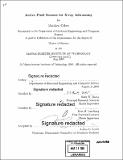Active pixel sensors for X-ray astronomy
Author(s)
Cohen, Matthew (Matthew L.)
DownloadFull printable version (11.96Mb)
Other Contributors
Massachusetts Institute of Technology. Dept. of Electrical Engineering and Computer Science.
Advisor
Mark W. Bautz and Kent H. Lundberg.
Terms of use
Metadata
Show full item recordAbstract
An active pixel sensor array, APS-1, has been fabricated for the purpose of scientific x-ray detection. This thesis presents the results of testing the device. Alternate design architectures are explored. Recommendations are made for a next-generation sensor. CCDs have been the dominant x-ray sensor in astronomy for over ten years. Limitations inherent to CCDs are starting to become important. Active pixel sensors (APS) provide an alternate architecture that may solve these problems. APS-1 is a first-generation sensor designed by Lincoln Laboratory's Advanced Silicon Technology Group. APS-1 is fabricated in a fully depleted silicon-on-insulator (FDSOI) technology. FDSOI is especially well-suited to produce a scientific x-ray imager. The device includes sixteen different pixel variations to determine the processing parameters that can produce the best imager. Dark current, noise, and responsivity of the various pixel designs was measured using an electronics system adapted from a CCD test system. X-rays were detected at room temperature. Ordinary active pixels have high noise levels ( 70 electrons). Many pixel designs capable of lower noise have been presented in the literature. Active reset, pixel-level CDS, and CTIA pixel designs are discussed in detail and simulated. A second-generation sensor from Lincoln Laboratory, using pixel-level CDS, is discussed. This device, APS-2, will be available for testing in 2006. APS-2 simulation results are presented. It is expected to have an input-referred noise of less than five electrons, near the performance of modern CCDs.
Description
Thesis (S.M.)--Massachusetts Institute of Technology, Dept. of Electrical Engineering and Computer Science, 2005. MIT Institute Archives copy: pages 151-158 bound in reverse order. Also issued in leaves. Includes bibliographical references (p. 155-158).
Date issued
2005Department
Massachusetts Institute of Technology. Department of Electrical Engineering and Computer SciencePublisher
Massachusetts Institute of Technology
Keywords
Electrical Engineering and Computer Science.